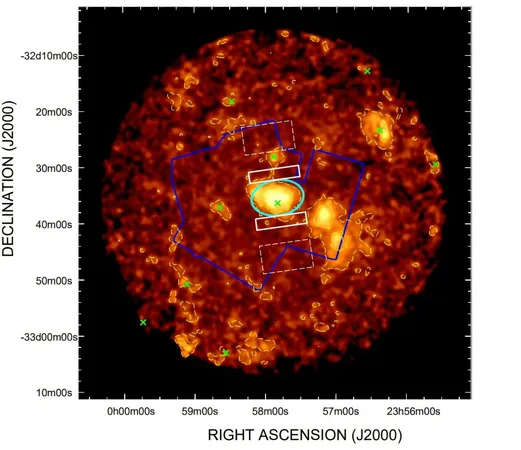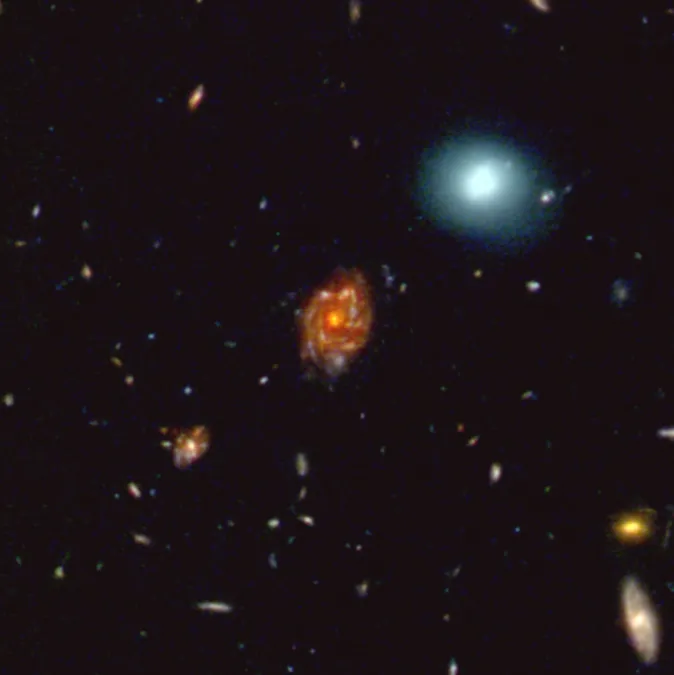
Groundbreaking Study Unveils Secrets of the Hot Halo Surrounding Galaxy NGC 7793
2025-03-25
Author: Ming
Introduction
A team of Chinese astronomers has made significant strides in our understanding of the remarkable galaxy NGC 7793, located approximately 12.2 million light-years from Earth. Leveraging data from the advanced Spektr-RG and Chandra space observatories, their findings shed light on the galaxy's hot gaseous halo, providing essential insights into the behaviors and characteristics of this celestial body.
Overview of NGC 7793
NGC 7793, a stunning unbarred spiral galaxy situated in the Sculptor Group, measures about 30,000 light-years in diameter and boasts a stellar mass of around 3.2 billion solar masses. Despite being discovered over 200 years ago, key aspects of its galactic X-ray emissions, particularly related to halo gas, had remained largely unstudied—until now.
Research Focus
Led by Lin He from Nanjing University, the research team focused on analyzing the diffuse soft X-ray emissions encircling NGC 7793. By examining early eROSITA data, along with archival observations from Chandra's Advanced CCD Imaging Spectrometer (ACIS), they made significant discoveries. They detected extraplanar X-ray emissions within the energy bands of eROSITA (0.4–2.3 keV) and Chandra (0.5–2 keV), indicating the presence of a hot gaseous halo surrounding the galaxy.
Significant Findings
This intriguing finding suggests that stellar feedback, driven by ongoing star formation, plays a crucial role in the development of this halo for low-mass spiral galaxies like NGC 7793. Notably, the researchers observed an unusual dip in the radial profiles of the galaxy, particularly pronounced in higher energy bands. This dip is believed to either result from a bubble-like structure or reflect fluctuations in the intragroup medium, influenced by NGC 7793’s location within the Sculptor Group.
Temperature and Mass of the Halo
The team further estimated the temperature of the hot gas surrounding NGC 7793 to be approximately 0.18 keV, with a total mass around 10 million solar masses. The luminosity of the unabsorbed hot gas is striking, measured at about 130 undecillion erg/s, extending as far as 19,500 light-years from the galactic center.
Implications and Future Research
The implications of this research are profound, as the findings underscore the vital role of continuous star formation in providing the necessary hot gas that enriches the galaxy’s halo. The authors advocate for additional investigations to deepen our understanding of NGC 7793's hot circumgalactic medium, suggesting that future observations could be significantly advanced using the upcoming Hot Universe Baryon Surveyor (HUBS) X-ray microcalorimeter.
Conclusion
This groundbreaking study not only enriches our knowledge of NGC 7793 but could also influence our understanding of similar galaxies across the universe. As astronomers continue to explore the cosmos, the secrets of our neighboring galaxies gradually come to light, redefining our grasp of galaxy formation and evolution.

 Brasil (PT)
Brasil (PT)
 Canada (EN)
Canada (EN)
 Chile (ES)
Chile (ES)
 Česko (CS)
Česko (CS)
 대한민국 (KO)
대한민국 (KO)
 España (ES)
España (ES)
 France (FR)
France (FR)
 Hong Kong (EN)
Hong Kong (EN)
 Italia (IT)
Italia (IT)
 日本 (JA)
日本 (JA)
 Magyarország (HU)
Magyarország (HU)
 Norge (NO)
Norge (NO)
 Polska (PL)
Polska (PL)
 Schweiz (DE)
Schweiz (DE)
 Singapore (EN)
Singapore (EN)
 Sverige (SV)
Sverige (SV)
 Suomi (FI)
Suomi (FI)
 Türkiye (TR)
Türkiye (TR)
 الإمارات العربية المتحدة (AR)
الإمارات العربية المتحدة (AR)